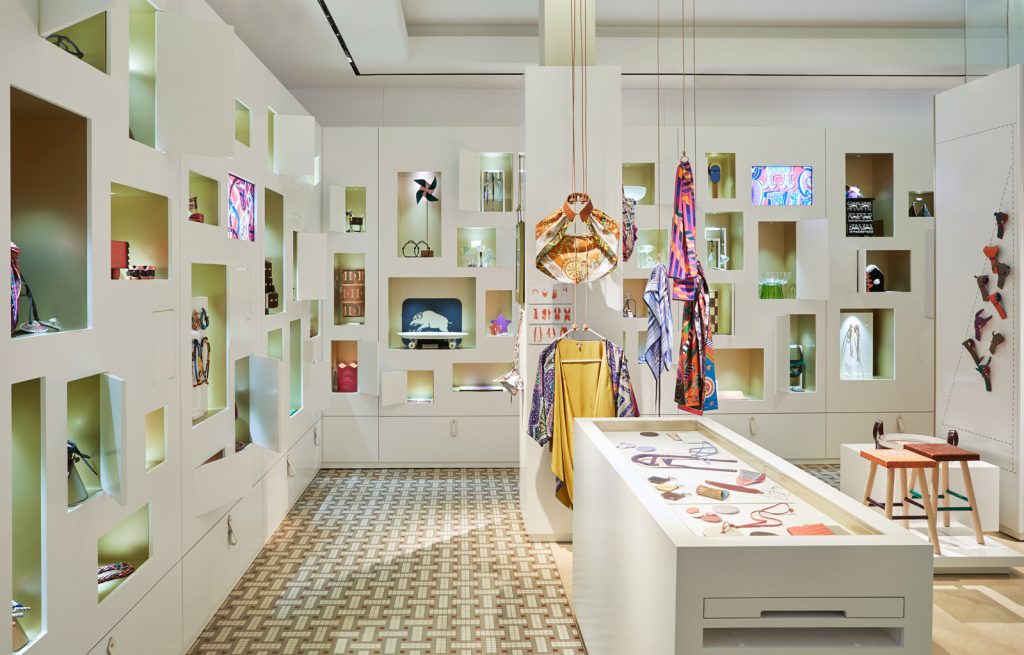Designing Hermès’ Petit H Holiday Factory
A look behind the specialized brand’s DML-produced interactive pop-up at the Madison Avenue shop

For over a century, Parisian luxury brand Hermès‘ commitment to quality has meant that no imperfect product made its way to retail. In 2010, any piece with an imperfection (and remnant material from production) found its way to a new home: the petit h workshop. There, specialized artisans—in silk, leather, porcelain and more—take the items and give them new life. Imperfections are replaced or highlighted with new materials; scraps are turned into imaginative “objets.” And a small offshoot line was born under the watch of artistic director Pascale Mussard, a sixth generation member of the Hermès family. Beyond a store in Paris and a small online presence, petit h maintains a low brick-and-mortar profile—except for pop-ups once or twice a year at a select Hermès shop around the globe. Last month, petit h set up on Madison Avenue. With the help of interactive creative agency DML, they built something above and beyond a traditional window display. The holidays have since passed, but looking back at the collaboration reveals a thoughtful affirmation of brand values and retail capabilities.

It all began with a concept presentation in June of last year. As Cooper Cox, president of DML, shares with CH, the idea was two-pronged. First, he says, “We wanted to take the experience of the petit h workshop in Paris and bring it to life in the Hermès flagship store in New York. There were a lot of wonderful details in the workshop that we were able to play with.” Further, he adds “We wanted to celebrate the traditional advent calendar by creating a modern abstract interpretation of it.” Inspired by hand-drawn illustrations from Mussard’s son, the artist Alexandre Mussard—and with the help of designers Checkland Kindleysides—this ultimately manifested in large-scale build-outs, including modular product units and a 120 inch vertical flat screen attached to a work bench. The latter showcased an interactive animation that would shift based upon the materials visitors touched beside it. Further, a customization station allowed guests to build their own ornaments. And despite the limitlessness of the presentation, it never veered from the Hermès brand. Even that knots used in a display rack were replicated from some seen on a research trip to the internal Hermès museum in Paris.

As expected, the presentation commenced outdoors—beginning with interactive windows. Here the advent calendar concept took shape, with each window either zooming in on one box or zooming out to highlight a few. “New York has a vibrant art community, we envisioned the windows as an exhibition and treated the featured petit h products like works of art,” Cox explains. From highlighting museum quality gold-laden or silk-bound pieces to referencing the famous Hermès boxes, each window introduced the passersby to the nature of petit h. DML incorporated neon lights, metal and even motion activation, all for the sake of whimsy.

“Hermès is a surprising, playful brand,” Cox continues. “With the petit h event, the goal was to draw a new customer into the store and give them a dramatic experience they could enjoy and share. At DML our specialty is to create retail theater, as physical stores are becoming ever more challenging spaces.” Cox and his team did not end there. “When you have a creative expression in the windows, there is a natural expectation that the creative carries itself into the store environment, and it’s rarely the case,” he says. Here, DML was motivated by something outside the ordinary. “We believe your physical retail store should be an exciting and memorable offline experience. Your customer should come away with a richer understanding of the brand and continue the journey online.” Embracing the whimsy and wonder, and applying it to an experience that’s just as much a gift to the consumer as it is a product display motivated further interactive elements.

Something further differentiates petit h from Hermès and informed DML’s wprl. With the former, all artisans across all materials exist in the same workshop. With the latter, dedicated facilities house specific craftsmen. To highlight this, DML’s focal point within the shop happens to be a deconstructed version of petit h’s most iconic creation, in chandelier form. The brand’s flying teapot has long been an item representing the workshop’s capabilities—as it incorporates silk, leather and porcelain all drawn from remnant pieces. As a chandelier dangling between the store’s spiral staircase, the larger-than-life work is visible from all angles.

Beyond their aesthetic value, the modular units also support the limited amount of stock and the notion that the pieces are all one-offs. “When product sells through, we were able to close off sections without the consumer being aware they were missing out,” Cox says. Every creation was afforded tailored attention. “Throughout the scenography, we treated each product as a unique work of art. We also give the consumer something to explore, and the opportunity to search through all of these boxes, to find something delightful,” he concludes. While the pop-up has closed, some petit h products can be purchased online.
Images courtesy of DML












